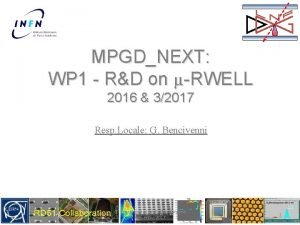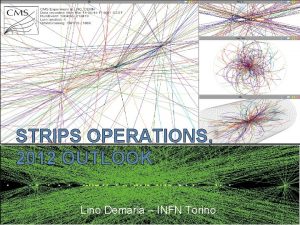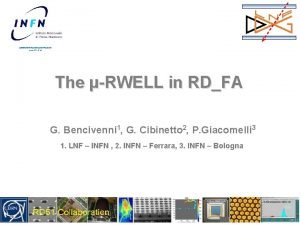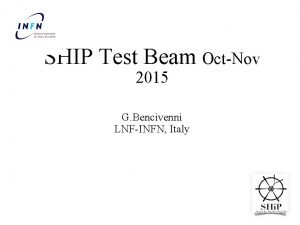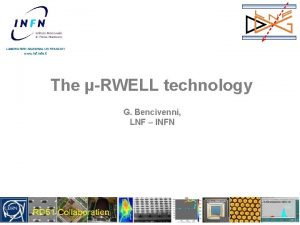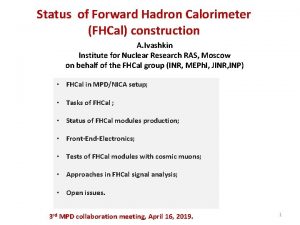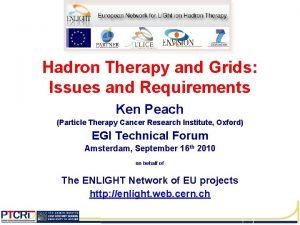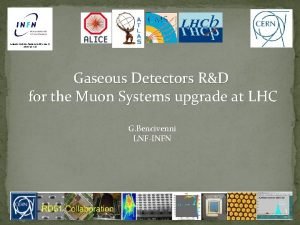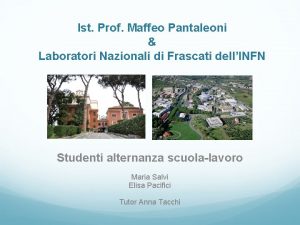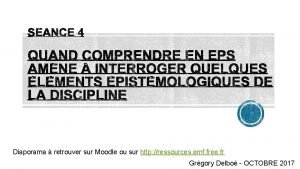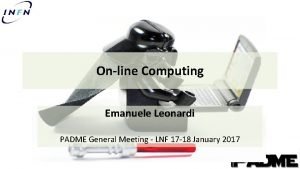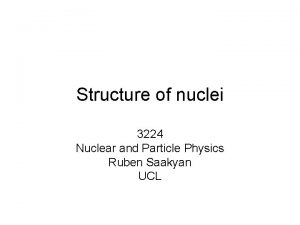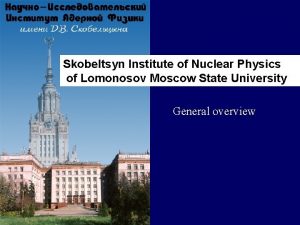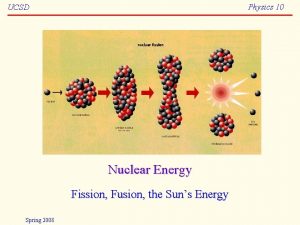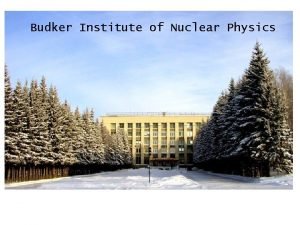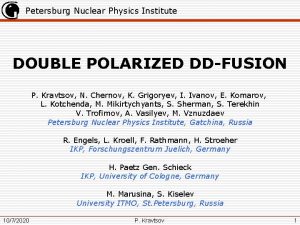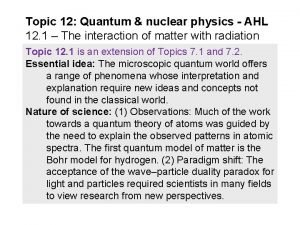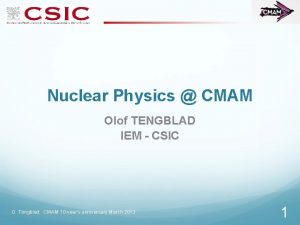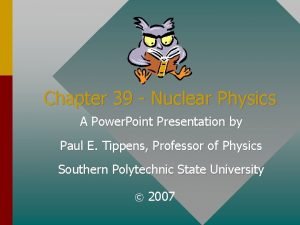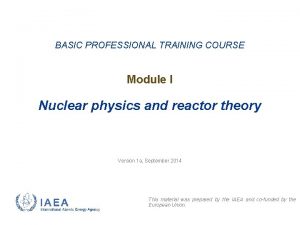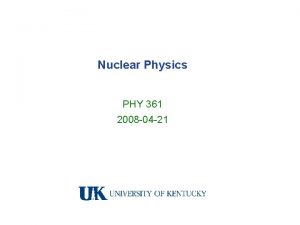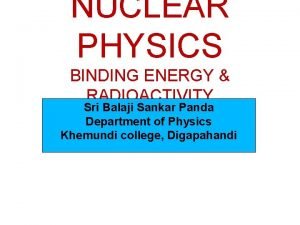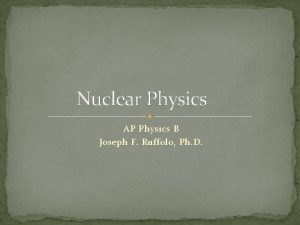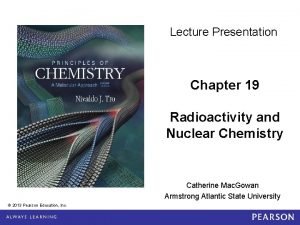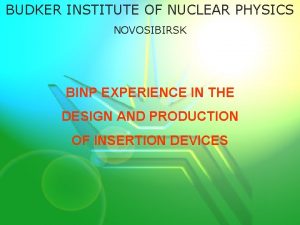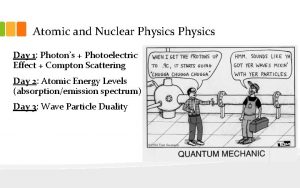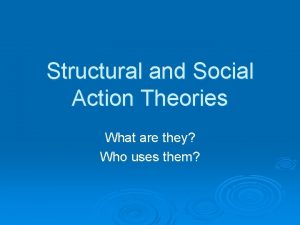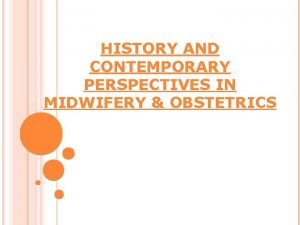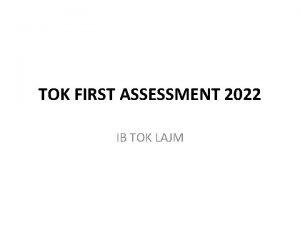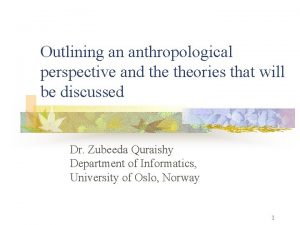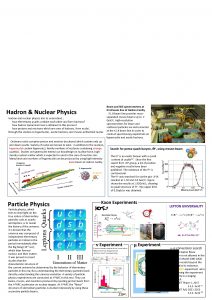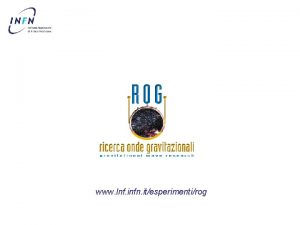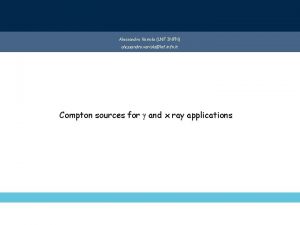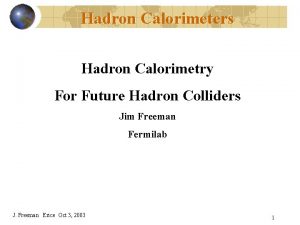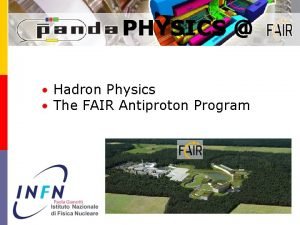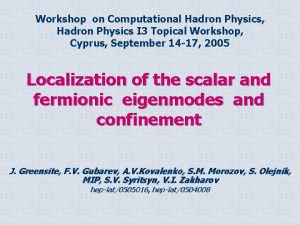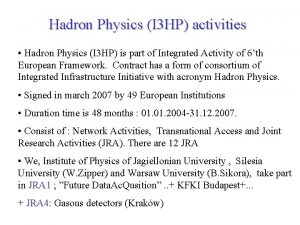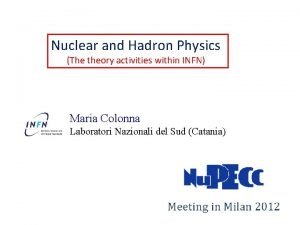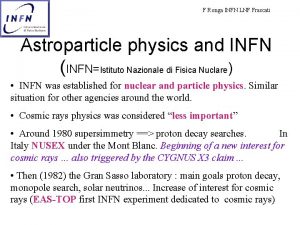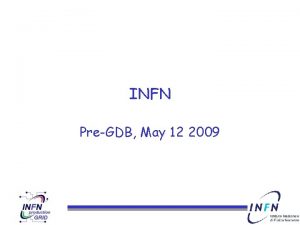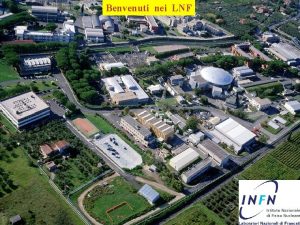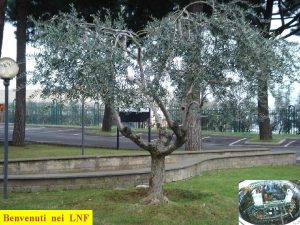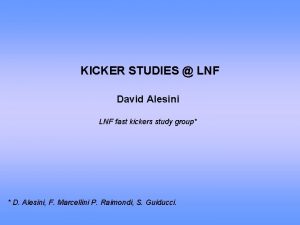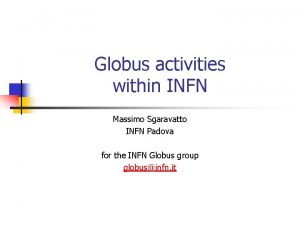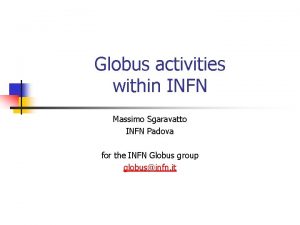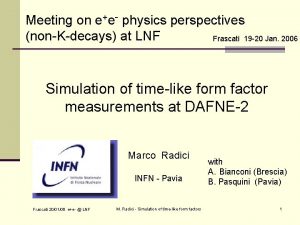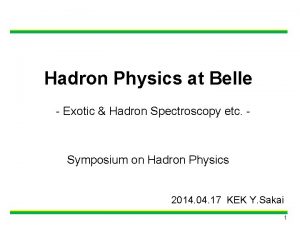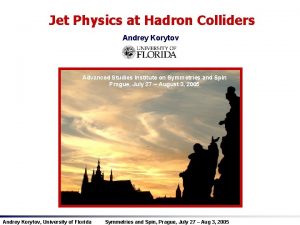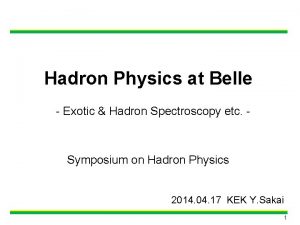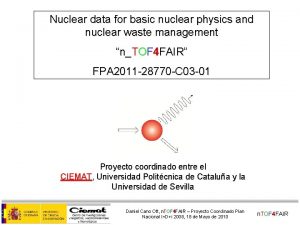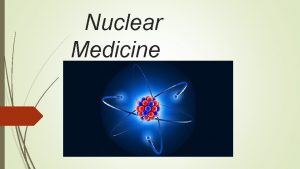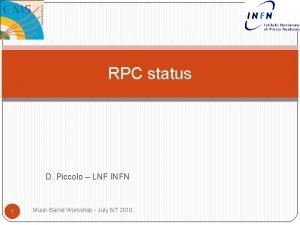Nuclear and Hadron Physics Perspectives within INFN LNF









































- Slides: 41

Nuclear and Hadron Physics Perspectives within INFN LNF, 18 October 2010 Angela Bracco

Æ The Nuclear Physics Scientific research lines : data from the 2009 report Æ Selected relevant results and perspectives for the next years Æ Nu. PECC Long Range Plan (and role of INFN) Æ Final remarks

Nuclear Physics : INFN laboratories and sections at Universities 15 sections + 4 national laboratories with research in Nuclear Physics

…. . The 4 scientific lines Line 1 -149 FTE: Quarks and Hadron Dynamics (Jlab- LNF- GSI) Line 4 - 71 FTE: Nuclear Astrophysics and interdisciplinary research (LNGS-LNS LNS, 11 -12 October 2010 - CCI meeting CSN 3 Line 2 - 198 FTE: Phase transitions in nuclear matter (160 in Alice) 542 FTE Line 3 - 121 FTE: Nuclear Structure and reaction mechanisms (LNL-LNS) Angela Bracco

CSN 3: Publications, presentations to conferences …. In 2009: 2009 % Pub % FTE 240 Papers 486 Conference presentations 698 Reserachers+ 99 Tech. 542 FTE Post doc 108 Line 1: hadron dynamics 65 Doctoral students Linea 2 : Phase Transition (16 doctoral thesis completed) 27 Master thesis – 23 thesis (3 years degree) Linea 3 : Nuclear Structure Linea 4 : Nuclear Astrophysics

Distribution of fundings and of FTE in the reserach lines Line 1: hadron dynamics Linea 2 : Phase Transition LNF, JLAB, GSI CERN LNL-LNS-LNG Linea 3 : Nuclear Structure Linea 4 : Nuclear Astrophysics

Quarks and Hadron Dynamics q Problem of the spin Nucleon form factors -Structure functions and GPD- (JLAB 12) q Barionic resonaces and Spectroscopy of mesons (JLAB 12 MAMBO-PAINUC) q Ipernuclei and Kaonic atoms (interaction Λ-N e K-N) (SIDDHARTHA- FINUDA) + N N W L -K S p N R&D for PANDA e PAX (antiprotons at FAIR)

JLab 12 collaboration Hall @ B: Jefferson Large angle. Lab spectrometer CEBAF (VA-USA) CEBAF: Continuous e- beam • Energymax 6 Ge. V till may 2012 • Energymax 12 Ge. V : may 2013 • 200 m. A, 75 -85% polarization • Beam simultaneously delivered to 3 Halls Hall A: 2 high resolution spectrometers • INFN @ JLab since 1991 • In 2009 all INFN groups merged into the JLAB 12 collaboration Bari, Catania, Ferrara, Genova, ISS, LNF, RMII AA BB C Ricercatori + Tecnologi: 47 (32. 5 FTE) Personale Tecnico: 31 (12. 7 FTE) 2010: 41/29. 5 FTE 2011: 47/32. 5 FTE

JLab 12 collaboration Italian Collaborators have been covering relevant roles in the Jefferson Lab community, as member of committees and chair of working groups and collaborations: • D. Bettoni, Member of the JLab Program Advisory Committee, 2010 -today • M. Ripani, CLAS Collaboration Chair, 2009 -today • R. De Vita, Secretary of the CLAS Speakers Committee, 2006 -today • M. Battaglieri, Chair of the CLAS Speakers Committee, 2005 -today • P. Rossi, Chair of the CLAS Service Work Committee, 2004 -today • P. Rossi, Member of the JLab Program Advisory Committee, 2010 • M. Ripani, Member of the JLab Program Advisory Committee, 2006 -2009 • R. De Vita, Member of the JLab User Group Board of Directors, 2005 -2007 • R. De Vita, Member of the CLAS Speakers Committee, 2003 -2006 • N. Bianchi, Member of the JLab Program Advisory Committee, 2003 -2005 • M. Battaglieri, Member of the CLAS Speakers Committee, 2001 -2005 • P. Rossi, Member of the CLAS Service Work Committee, 2003 -2004 • M. Taiuti, Chair of the CLAS Structure of the Nucleon Working Group, 2001 -2004 • M. Taiuti, Member of the JLab Program Advisory Committee, 2000 -2002 • E. De Sanctis, Member of the JLab Program Advisory Committee, 1997 -1999 • G. Ricco, Member of the JLab Program Advisory Committee, 1995 -1996

Nucleon structure and nucleon excited states • number of states > observed (quark degrees of freddom) • measured energies < predicted (quark-quark residual interaction) - (qq angular momentum) L = 0 1 2 3 4 5 Barionic resonances mainly studied with π Measurements in the strangeness sector to serach for missing resonances Comparison data -theory (Regge) – presence of resonances Esperiment INFN JLAB 12 – high precision data

Nucleon spin at JLAB k 0. 3 • Longitudinally polarized • (NH 3/ND 3) target (Pol. >75%/30%) • Lumi=1. 5. 1034 cm-2 s-1 small could be large 3 months data taking: ~ 10 times HERMES statistics in 6 years! To obtain information on correlations between transverse momentum of quarks (k ) and the spin of the quark/nucleon

Esperiment JLAB 12 12 Ge. V CEBAF Central TOF Solenoid Detector design for CLAS neutral detectors based on SCINTILLATOR BARREL Neutral Detector Tracker (SVT, Drift Chambers) Attività di upgrade in HP 2 del FP 7 Contributo al nuovo tracciatore con riv. GEM Importante per exclusive reaction studies - n-DVCS

Equipments / Experiments Matrix @ 12 Ge. V HD Target Central Detector RICH CLAS 12 Forward Tagger X BA X X FE X GE X X ISS X LNF X X X TMD GPD 21 Set 2010 / CSN III X X X X RM 1 Physics Si Detector X CT RM 2 GEM Tracker X TMD Meson JLab 12 - E. Cisbani FF, TMD, FF, TMD PVES 13

A neutron detector for CLAS 12 Physics Motivation: LTCC Measurement of n. DVCS e’ e TOF L* t Ji’s sum rule → access to quark orbital momentum (Q 2) DC R 1, R 2, R 3 x+ξ n 2 Jq = x(H+E)(x, ξ, 0)dx x-ξ ~ (x, ξ, t) H, H, PCAL E, E n’ LOI 12 -09 -001: Deeply virtual Compton scattering on the neutron with CLAS at 11 Ge. V R. De Vita, M. Mirazita co-spokesperson EC PAC: “Collaboration strongly encouraged to complete the required R&D and bring forward a proposal” Solenoid 5 T Solenoid > 80% of the neutrons with >40° Central TOF CD SVT Neutron Detector HTCC TORUS Average neutron momentum 0. 3 -0. 5 Ge. V/c Central Detector Tracker • European Project (France, Italy, UK) and Foreign (Corea, Russia) groups • Included in Hard. Ex JRA within the FP 7 Forward Spectrometer Angular coverage: 40 o - 135 o

A RICH detector for CLAS 12 Charged particle Radiator C RI Proximity gap Results from a stand-alone MC Pad size Gap = 100 cm Radiator = 3 cm aerogel (n=1. 03) H RI C Photon detector Aerogel mandatory to separate hadrons in the momentum range 2 -8 Ge. V/c The initial option based on freon C 6 F 14 radiator and a Cs. I-deposited MWPC chamber as a UVphoton detector has been rejected because doesn’t achieve the required pion rejection factor at momenta greater than 3 -4 Ge. V/c Collection of the visible Cherenkov light Mandatory small pad size (< 1 cm)

A Forward tagger for CLAS 12: R&D Plan Compare different crystals Pb. WO from Hangzhou Company (China) Pb. WO-II from BTCP (Russia), 15 x 200 mm 3 LYSO from Saint-Gobain Test different light sensors Hamamatsu 5 x 5 mm 2 APD Hamamatsu 12 x 5 mm 2 LAAPD Hamamtsu Si. PM (3 x 3 mm 2, 4 x (3 x 3 mm 2) Array, 16 (3 x 3 mm 2) Array Test electronic chains CLAS-IC preamplifier for APDs PANDA preamps for APDs Custom electronics for Si. PM (EUSO, ALICE-NINO) § Tests with cosmic rays and radioactive sources in Genova § Tests with 500 Me. V electrons at the BTF in Frascati Mechanicaland design in collaboration with Orsay Detector Group

SBS Spectrometer in Hall A • • Large luminosity Moderate acceptance Forward angles Reconfigurable detectors Si. D 21 Set 2010 / CSN III JLab 12 Responsibility: • Front Tracker (GEM+Si. D) • Readout Electronics JLab 12 – SBS@12 Ge. V - E. Cisbani 17

Front Tracker Beam Tests • DESY Test. Beam/09 -10: – Electron beam from ~ 1 to 7 Ge. V, Si. D telescope available – Noisy environment (stimulating noise studies) – Test overall configuration, 2 x. GEM, electronics, final size 40 x 50 cm 2 module • PREX/10: – Conditions approaching final configuration – (real exp. / not a test beam) • CERN/RD 51 TB: – High luminosity, magnetic field JLab 12 - E. Cisbani 21 Set 2010 / CSN III 18

BARIONIC RESONANCES 1. 5 Ge. V -3 Ge. V MAMBO experiment Precise measurements of beam-helicity asymmetry for double pion photoproductions on proton New data from MAMI (PRL 103, 052002(2009) Rigorous test for developments to extract resonance contributions Future experiments at Bonn with polarized beams and targets BGO ball (ex-GRAAL) mounted with a Spectrometer for charged particles

…. . Λ decays in nuclei……. from FINUDA (LNF) hypernucleus mesonic decay N p ΓT = ΓM + ΓNM ΓM = Γπ0 + ΓπΓNM = Γn + Γp + Γ 2 hypernucleus non-mesonic decay N p. N ~ 400 Me. V/c N W W p. F ~ 270 Me. V/c L th. prediction previous data Decadimento mesonico p N suppressed by Pauli blocking present data S FINUDA L FINUDA Decadimento non mesonico

Electroproduction of Hypernuclei in Hall. A Study L-N Interaction potential Hypernucleus Scattered electron Detected by HRSe K+ e’ Published L Kaon detected by HRSk N…N L * beam s. N contribution) 16 O 16 N L (unmatched peak may indicate large s. L term from data) H L, S 0 (elementary process) Experimental requirements: p p e Reactions Investigated: 9 Be 9 Li (3 spin doublets, information on D) L 12 C 12 B (clear evidence of excited core states -> L N…N Excellent Energy Resolution Detection at very forward angles (6° to obtain practical counting rates septum magnets) Excellent Particle Identification, unambiguous kaon selection RICH High luminosity Nucleus 21 Set 2010 / CSN III JLab 12 – Hypernuclei - E. Cisbani 21

Kaonic atoms at LNF (SIDDHARTA) Measurement of the energy for the level 1 s for the hydrogen kaonic PLB 681 (2009) 310 Kaonic 4 He atom siddharta preliminary In agreement with theory For Kaonic deuteron more data with an improved set up and electronics are needed – proposed in the next years Complementary experiments are made at JPARC

Confinement Spectroscopy ØSpectroscopy of charmonium in formation experiments ØStudy of gluonic excitations (hybrids and glueballs) and other exotics (e. g. multiquark states) ØStudy of hadrons in nuclear matter PANDA Asymptotic freedom non perturbative QCD ØPhysics of open charm ØPhysics of Hypernuclei Nucleon structure üForm factor Timelike of proton üCrossed-Channel Compton Scattering üDrell-Yan The ring HESR at the FAIR facility will provide p of unprecedented quality. The momentum will be up to 15 Ge. V/c (√s 5. 5 Ge. V).

PANDA Attività di R&D -Writing of TDR Straw Tube Tracker-LNF Attivity on the micro-vertex detector Simulation activity TDR on Solenoid Contribution of INFN was essential Jet target development

Spin Filtering method (interaction of antiprotons non polarized with polarized hydrogen) 1. Test with protona at COSY + study of depolarisation from electrons 2. Measurements with antiprotons at AD/CERN (>2013) The accelerator vacuum is going to be Improved !

pp collision at 7 Te. V

“First physics” with con pp Important reference data for the program with heavy-ion Minimum bias running very low-momentum cutoff (<100 Me. V/c) pt-reach up to 100 Ge. V/c l l Measurements of molteplicities l d. Nch/d and ds/d. Nch l Measurements of spectra in p. T measurements of resonances production l r 0 p+ p- l Φ K+ K- l K*(892) K+ p- l L*(1520) p K-

first LHC physics paper Nov. 28 2009 …sufficient to measure d. Nch/d first LHC physics paper submitted on Nov. 28 2009 ALICE Collaboration Eur. Phys. J. C 65: 111125, 2010

……. . at 7 Te. V in ALICE → K+K TOF PID Ξ → Λ+π neutral strange particles anti (nuclei)

Nuclear Structure and reaction mechanisms 5 -10 Me. V/u Heavy-ions GAMMA- PRISMA - EXOTIC- NUCLEX 50 Me. V/u MAGNEX- LNS_Stream - Fribs - Exochim Exctreme conditions for nuclei Reactions and decays • Nuclear structure • Equation of state astrophysical implications nucleosynthesis + coll with GSI and GANIL

Esperiments at GSI at the Fragment separator with the array RISING Life – times β decays Test theory!! Gamma and beta decays for the study of the r-process of the nucleosynthesis. For neutron rich Pb nuclei Gamow. Teller strength – predictions largely varying.

AGATA Demonstrator inauguration 9/5/2010 Measurement campaign (with ALPI) Focussed on nuclear collectivity in nuclei From low-lying vibrations and rotations to giant resonances GANIL 70 Ni 72 Ni LNL effect of neutron orbitals and role of tensor force Several data analysis in progress 16 ke. V Excellent energy resolution and high count rates

AGATA Demonstrator/1Π Experimental program June 2011 LNL 6 TC AGATA D. +PRISMA Total Eff. ~6% Dec 2011 GSI/FRS ≥ 8 TC AGATA @ FRS Total Eff. > 10% July 2013 GANIL/SPIRAL 2 ~15 TC AGATA + VAMOS + EXOGAM Total Eff. > 20%

Isospin dependence of the equation of state Experiment EXOCHIM (CHIMERA) The radius of neutron stars depends on the value of the symmetry energy (related to the N-Z difference) in the equation of state Mieasurements of charged particles 40 Ca+40 Ca+46 Ti 48 Ca+48 Ca Isospin effects in multifragmentation at Fermi energy Measurements of gamma-rays 40 Ca+48 Ca Data EXOTIC LNS-STREAM Mass of the largest fragment Multifragmentation with CHIMERA Experiments at the higher energy at GSI in 2011 Tests already made gamma radiation with the MEDEA apparatus

Fragmentation of beams at LNS : reaction with 16 C and 3 Be at 50 Me. V/u 18 O primary beam Unique energy interval ! -magnet setting on 11 Be strip 140 mm thick Trasmission will be improved Production studies in progress 16 C Elastic cross-section 16 C 13 B 10 Be 13 Be 7 Li Activity Exp. FRAG and EXOCHIM 10 Be 13 Be y r a n i im l e Measurements r P with CHIMERA 104 -5 pps

relative probability Nuclear astrophysics and interdisciplinary reserach Maxwell-Boltzmann tunneling through distribution Coulomb barrier 1/2 E exp(-E/k. T) exp -(E 0/E)1/2 Gamow peak k. T E 0 Energie ≈ Me. V Reactions at stellar energies for : • Energy generation • Nucleosynthesis energy (exp LUNA, ASFIN e ERNA) • Neutron capture for astrophysics and application in reactors of new generation. n_TOF al CERN • Annichilation of anti protons in nuclei 5 ke. V – 5 Me. V region of cosmological interest ASACUSA + R&D AEGIS • Pauli principle violation in atomic transitions (LNGS) (exp VIP)

LUNA at LNGS 15 N(p, )16 O Gas and solid targets give consistent results. - Severe test to theory (R-matrix) usually employed to extrapolate LUNA 15 N(p, γ)16 O and 15 N(p, α)12 C : “bridge” reactions between CNO I e II. Consequences for O and next CNO cycles. Important in the novae explosion and in AGB stars

Cross section measurements of neutron capture of astrophysical interest and for emerging nuclear technologies. 240 Pu(n, ) 237 Np(n, F) N_TOF First capture measurement in the region of reslved resonances (up to 1 ke. V). 6% accuracy (up to 1 ke. V). Information on nuclear properties (level spacing, average gamma widths, etc…) were deduced. New detector fission and alpha Total number of e protons for the approved experiments (up to now): 40 x 1018 (> 3 years)

LRP 2010 Nu. PECC Recommendations • Complete ESFRI Facilities – FAIR with PANDA, CBM, Nu. STAR and APPA – SPIRAL 2 at GANIL including S 3 and DESIR • Perform Major Upgrades – – HIE-ISOLDE at CERN SPES at INFN-LNL AGATA SC Linac at GSI • Support ALICE at CERN – Upgrades for nuclear beams programme at LHC to expand physics reach • Support Theory – RI ECT* in Trento – Projects for advanced studies related to the experimental roadmap – Dedicated high-performance computing facilities • Fully exploit Existing Facilities – Lepton beam facilities ELSA in Bonn, MAMI in Mainz, COMPASS at CERN, DA NE at INFN-LNF, and hadron beam facilities COSY at FZ Juelich and GSI in Darmstadt – Heavy ion beam facilities at JYFL, KVI, GSI, GANIL, IPNO, ISOLDE, INFN-LNL and INFN -LNS – AD at CERN & upgrade ELENA – Smaller scale national and university labs across Europe • Support Nuclear Physics applications & education • Promote Planning for Future Large. Scale Facilities – EURISOL as RI in future updates of ESFRI list – Technical Design Study for intense radioactive beams at ISOL@MYRRHA – Technical Design Studies for PAX and ENC at FAIR – Technical Design study for nuclear physics experiments & applications at ELI – Technical Design Study for LHe. C at CERN 39

CONCLUSION • The INFN involvment at JLAB with the very active groups of LNFROMA 1 -ROMA 2 -GENOVA-FERRARA-BARI and PAVIA and Torino (Theory)is highly appreciated. The scientific and tecnical results are excellent and the INFN researchers have prominent roles. • ALICE is collecting data with p and producing papers. Ready for the Pb-Pb data taking. • The first experimental campaign with the AGATA gamma tracking array (demonstrator) has started at LNL. Investigate Nuclei at extremes of isospin. • Esperiments at LNS and LUNA are engaged in upgrades • Long range plan del NUPECC is in print HADRONIC CHAPTER- emphasises the important role of JLAB for the European Physicists More resources are needed to keep the timelines !

SPES ISOL facility Cyclotron 750 μA, 70 Me. V (max) for protons in two exit ports: • RIB - up to 300 μA p on UCx • Application - up to 500 μA Additional target station (special plants second priority) RIB or neutron production transport/beam cooler/separator Charge Breeder 1+ n+ UCx target station 1013 fission/s G. Prete High Resolution Mass Spectrometer 1/20000 (Post Accelerator)
 Www.lnf.infn.it
Www.lnf.infn.it Infn torino webmail
Infn torino webmail Www.lnf.infn.it
Www.lnf.infn.it Lnf.infn.it
Lnf.infn.it Lnf.infn.it
Lnf.infn.it Hadron calorimeter
Hadron calorimeter Hadron collider
Hadron collider Hadron collider
Hadron collider Lhc tantalizing new physics
Lhc tantalizing new physics Hadron
Hadron Lesson 15 nuclear quest nuclear reactions
Lesson 15 nuclear quest nuclear reactions Fisión nuclear vs fision nuclear
Fisión nuclear vs fision nuclear Quantum and nuclear physics
Quantum and nuclear physics National literacy framework
National literacy framework Www.lnf
Www.lnf Pantaleoni frascati
Pantaleoni frascati Moodle espe lnf
Moodle espe lnf Lnf online
Lnf online Lnf foundation phase
Lnf foundation phase Shell model of nucleus
Shell model of nucleus Skobeltsyn institute of nuclear physics
Skobeltsyn institute of nuclear physics Nuclear energy
Nuclear energy Scattering cross section in nuclear physics
Scattering cross section in nuclear physics Budker institute of nuclear physics
Budker institute of nuclear physics Petersburg nuclear physics institute
Petersburg nuclear physics institute Physics topic 12
Physics topic 12 Nuclear physics
Nuclear physics Nuclear physics topics for presentation
Nuclear physics topics for presentation Nuclear physics
Nuclear physics Nuclear physics
Nuclear physics Nuclear physics
Nuclear physics Nuclear physics b
Nuclear physics b Magic number
Magic number Nuclear physics
Nuclear physics Budker
Budker Nuclear physics day
Nuclear physics day Social structure examples
Social structure examples Professional nursing practice concepts and perspectives
Professional nursing practice concepts and perspectives Historical and contemporary perspectives ppt
Historical and contemporary perspectives ppt Chapter 4 child development
Chapter 4 child development Optional themes tok
Optional themes tok Anthropology perspectives
Anthropology perspectives
